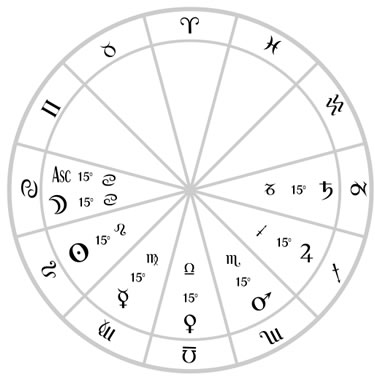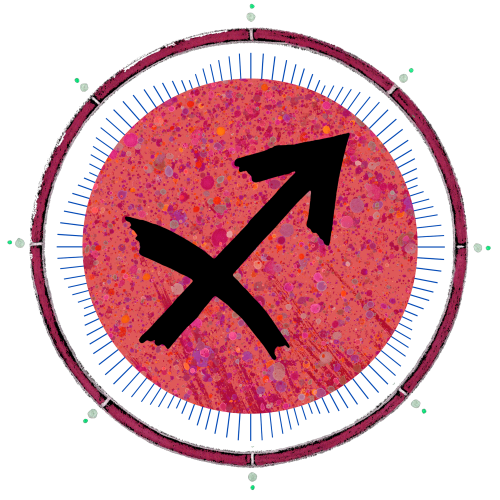
By Eric Francis
ONE OF my esoteric teachers, the late Arthur Joseph Kushner of New Paltz, liked to say there was a time when all things began. Sometimes the best teachings are the very simplest, though this is an easy one to forget. All that exists has its origins in time.Things and activities that date to immemorial antiquity did indeed one day came into being. Yesterday they were not there; then today, they are here. Whether you’re talking about the use of tarot cards for divination, the first time someone intentionally made a chair, or the peanut butter and jelly sandwich, one day it happened.

Usually the origins of things are lost to time. Humans are inherently migratory critters, and many of our documents and artifacts are lost in movement along with my MS Office 98 disk. Stories are forgotten or lost as languages die, libraries burn or are burned, and of course constant warfare and religious persecution obscures history.
We don’t usually think of astrology as having an actual origin. Personally I always imagined the birth of astrology happening as someone looked up at the night sky, their imagination taking over as they made up a story.
I have associated astrology with folklore, which is decidedly not astrology — forgetting what Arthur took the time to explain: that all things, and astrology is definitely a distinct thing, have a distinct point of origin, even though you may never know what it was.
At last weekend’s conference of NCGR, the National Council for Geocosmic Research in Baltimore, I was given some information that has begun to rearrange my astrological thinking more than anything, well, since Chiron.
Beginning in 1993 (around the time of the Uranus-Neptune conjunction in Capricorn), something called Project Hindsight was created. We know its origins: Roberts Hand, Schmidt and Zoller were its original members, though two of the Roberts have gone their own way.
Since then, Hindsight has more or less continuously been translating astrological texts out of ancient languages, principally Greek and Latin, but also Hebrew, Aramaic and others. I was fortunate to be introduced to Hindsight by one of my teachers just two years after it began. They have made many discoveries from a number of ancient cultures, but in the past few years the researchers have begun to understand the astrology of the Hellenistic era, which is at the root of our astrology.

We often think our astrology came from Arab mathematicians and astronomers, but actually, the Arabs were mostly using texts translated from Greek, dating to about the second century BCE.
That, says Robert Schmidt, one of the creators of Hindsight, is when Hellenistic astrology, the entire system, seems to have appeared, within a time span of about 50 years. When you consider that it can take most of 50 years to learn astrology, the notion that an entire sophisticated system — with houses, planets, signs, numerous calculation methods, interpretive rules and so on — was invented, developed, or discovered within that short timeframe, is astonishing. But one way or another, that appears to be what happened.
Original documents in ancient Greek were amassed mainly in two collection projects in the 20th century: that of David Pingree, and another earlier collection called the CCAG series. Those pertaining to astrology have been translated by Project Hindsight researchers, for the most part by Schmidt, who is fluent in ancient Greek and other languages. From this literature it is clear that there are seven “founders” of Hellenistic astrology, and that one of them is Hermes Trismegistus.
Did he bring his astrology from somewhere else, or have a source of access to ancient knowledge that had somehow been concealed? As usual, a discovery conceals a deeper mystery or two. We don’t really know who Hermes Trismegistus was, where he came from, or when he lived. Speculation abounds, and it’s fun to consider. Is it accurate? I don’t think God even knows what they will be saying about Oprah in 3,000 years, but I’m sure we would laugh ourselves silly if we could hear it.
In my conversations last weekend with Schmidt and his wife Ellen Black (one of which is posted to our audio section), I learned many strange things, but the one that stands out is the existence of a document called the Thema Mundi. This is the “chart of the world.” Many traditions and people have pondered the existence of such a chart, and one appears to exist, at least in name.
The Hellenistic scholars who write about it refer to it as a teaching device, so it seems likely to be a hypothetical chart, that is, a construction rather than a chart for an event, but one with placements that have occurred many times in history. What Schmidt and Black have deduced from their research is that this seems to be a chart that is the foundation for the system of Hellenistic astrology, which in turn gave us the astrology we now have.

In other words, rather than being a chart that was put together based on the rules of the Hellenistic system, it is the key to our astrology, something of an original document from which those rules were deduced. Of course, nobody can say for sure and the literature is not clear on this particular point. The chart exists and was used, and we now have access to it.
Yesterday in a phone conversation, Schmidt likened his perception that the chart is the source of astrology rather than the other way around, to seeing a film of a cup breaking, played backwards.
Imagine that’s all you had, the reverse film. If you watched the film, you would need to speculate about all the possible forces that were pushing the various bits together to shape them in the form of the cup, then assume there was some way they were mysteriously sticking together. You might wonder what intelligence orchestrated the shards arranging themselves as a cup.
If you start with a cup, watch it break, and then watch it come back together, it makes a lot more sense. On this logic, it makes sense to presume the Thema Mundi is a starting point rather than a destination or logical conclusion of the Hellenistic principles.
The chart has seven planets, since that’s how many were known at the time — though I often wonder about why nobody seems to have noticed Vesta, which is almost always visible without a telescope, and which people looking at the sky should have noticed moving around up there (that is another discussion). In the Thema Mundi, the planets are all in their traditional rulerships. The Moon is in Cancer and the Sun is in Leo. Mercury is in Virgo, Venus is in Libra, and Mars is in Scorpio. Jupiter is in Sagittarius and Saturn is in Capricorn. The rest of the signs, and houses, are empty.
Now here is the interesting part. The chart has Cancer rising. And it would appear that the overlay of houses and signs of our astrology is based not on Aries being associated with the 1st house, but rather, Cancer.
If you studied astrology any time after the early 20th century, you were taught pretty much as a matter of rote memorization that the 1st house corresponds to Mars and to Aries. This became a popular way to conceive of what Schmidt calls the “12 letter alphabet” of astrology in the 1970s, and you often hear associations like “Sun = Leo = 5th house.”
Personally, I have always found this to be irritating and somewhat thoughtless, as is the simplistic assertion that “signs and houses mean the same thing.” In particular, the way the houses work and feel is quite distinct from the way the signs work. They are related, sure. The relationships are sometimes obvious, but often there are surprises, and it’s often much less straightforward than astrologers say. Based on the Thema Mundi it would appear that we have had our system skewed by 90 degrees. The “natural chart” correspondence of houses to signs to planets, according to the Hellenistic system, is as follows below. Note that only the first seven houses are occupied in the Thema Mundi, abbreviated below as “TM.”
| 1st house | Cancer | The Moon |
| 2nd house | Leo | The Sun |
| 3rd house | Virgo | Mercury (Hermes) |
| 4th house | Libra | Venus |
| 5th house | Scorpio | Mars |
| 6th house | Sagittarius | Jupiter |
| 7th house | Capricorn | Saturn |
| 8th house | Aquarius | (Saturn, empty in TM) |
| 9th house | Pisces | (Jupiter, empty in TM) |
| 10th house | Aries | (Mars, empty in TM) |
| 11th house | Taurus | (Venus, empty in TM) |
| 12th house | Gemini | (Mercury, empty in TM) |
Note, this is a nocturnal chart. The Sun is below the horizon. In ancient astrology this makes a big difference, a distinction that is now getting the attention of more astrologers entirely because of the Hindsight work.
From this key, you can pretty much deduce all the basic rules of Hellenistic astrology, and understand your own astrology a lot more clearly.
Note that we still have cardinal signs on the angles. In other words, in the system we’re accustomed to, Aries, a cardinal sign, is the “ascendant.” In this system, Cancer, another cardinal sign, is the ascendant. Cancer is the sign of mothering, and is associated with the ascendant, which is the house of incarnation, where you come from the misty void of the 12th house into tangible form in the 1st house. In fact, Alice Bailey, in her book Esoteric Astrology, makes a similar case for the sign Cancer, saying that it’s the sign of incarnation. Note that many “traditionally trained” astrologers have long poo-pooed Alice Bailey as being drivel.
For its part, Aries turns up as the 10th house of the Thema Mundi, which is a house with a lot of fiery initiative — career, fame, expression in the world. Yes, the 10th seems to have some connection to Capricorn in our system, but speaking as one who must interpret regularly using the newer (incorrect) system, Capricorn does not exactly fit the outgoing initiative required of the 10th. I’ve had to fudge by taking Cap as a cardinal sign and getting the initiative from there, the property of cardinality (astrological lingo for initiative), which works well enough — but not as well as having Aries as the natural sign associated with the 10th house. This helps us understand the Aries Point, which seems a lot closer in meaning to the 10th cusp than it does to the ascendant.
Let’s look at a couple of more examples, and then let this information sit for a while, and let our minds adjust to the 90-degree reality shift. Consider the 5th house. Before being aware of this information, here is how I characterized it in my house definition listing:
The house of taking risks, pleasure, play and creative love. These all call upon a person to dare. Of all the previous houses, the 5th has the greatest feeling of surrender. Romance, children, adventure, gambling, bungee jumping, hang gliding, and sex for fun or passion, including when you’re in love. This house can have an unusual karmic quality to it; there is a relationship to something that’s beyond immediate experience or perception but which activities of that house can bring out.
Hmm. An “unusual karmic quality” (not referenced by most books, which will leave you with the 5th as a romantic weekend in Las Vegas). Scorpio is reminiscent of this feeling. And the mix of Leo and Scorpio is much more reminiscent of the passion and surrender of the 5th house, and what you happens when you really dare, than is a Leo connection.
Now, what I did not mention in this interpretation (and why it’s never a good idea to get your information from just one source) is that children are often conceived in the 5th house, and that makes a lot more sense when you overlay the house of passionate sex with the sign of the mysteries of birth and death. We also get an idea of why, when you embark on what seems like a fun romance, you can end up involved deeper than you planned. We have a picture of why, besides the obvious, the 5th house lands you in Scorpio Land.
Let’s take one more example on this theme. In an article I wrote in February 2000 for StarIQ.com, called “Beyond Death and Dowry: Astrology Points to a New Sexuality,” I presented a discussion suggesting that we consider Aquarius and the 11th house as a model for sexuality, rather than the usual Scorpio model. Basically, I was suggesting that we make a 90-degree axis rotation in our notions about sexuality, ease off on the property right aspects insinuated by the 8th house (which covers many aspects of sex, as well as death, and by extension, things like inheriting money), and tune into a more communal idea of sex and relating.
It seemed innovative at the time, but the founders of Hellenistic astrology were about 22 centuries ahead of me. Aquarius is the sign associated with the 8th house. What we think of as the most private affair, be it sharing an orgasm with someone or what someone says at the time they are dying, is processed through a sign that is associated, at least in modern astrology, with the community, groups and associations.
In actual fact, sex is inherently a community matter. We see this in every way, from gossip to the influence that relationships have on the community; from how we must consider the transmission of STDs as something that affects us all, to the odd tendency a good number of people have to experience a series of partners and exist in a form of polyamory called an intimate network (even though it’s given the name ‘monogamy’). There is the implication that we need to apply visionary ideas and ideals (Aquarius style) to our process of give and take with sexual relationships (the 8th house).
The 8th covers marriage contracts and contracts of all kinds, and we get an image of why the marriage commitment is typically conducted in public, with a group present. We can also see that beneath any formal agreement between two people is a level of reality, signified by Aquarius, where that connection is part of the broader matrix of society. Nothing, and no association, exists in a vacuum; we are all part of the world.
The Thema Mundi has many implications, for every subject covered by astrology, and even knowing about the thing feels like being handed the secret of how astrology works, or like pulling up the floor boards and seeing what we’ve been walking over all these years. There are several permutations of the chart, including one that has the planets placed in their signs of secondary rulership (Jupiter also rules Pisces in the ancient system) and their signs of exaltation (for example, Saturn is exalted in Libra), a discussion I’ll take up in a later edition. All the charts have Cancer in the ascendant.
For now, have fun considering the chart that truly is one of the ancient keys to astrology. Keys lead to doors and doors lead to different places — this is the beginning of an adventure.




